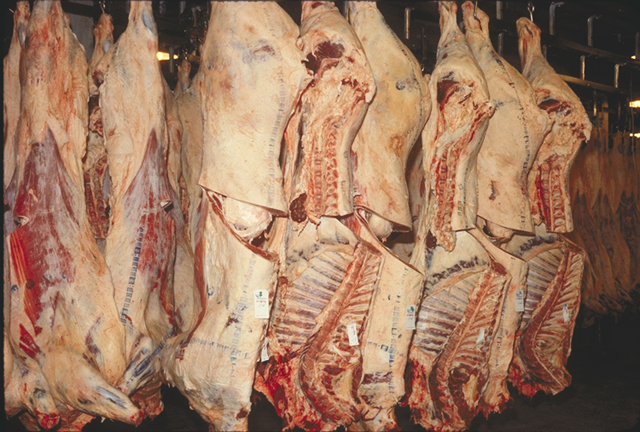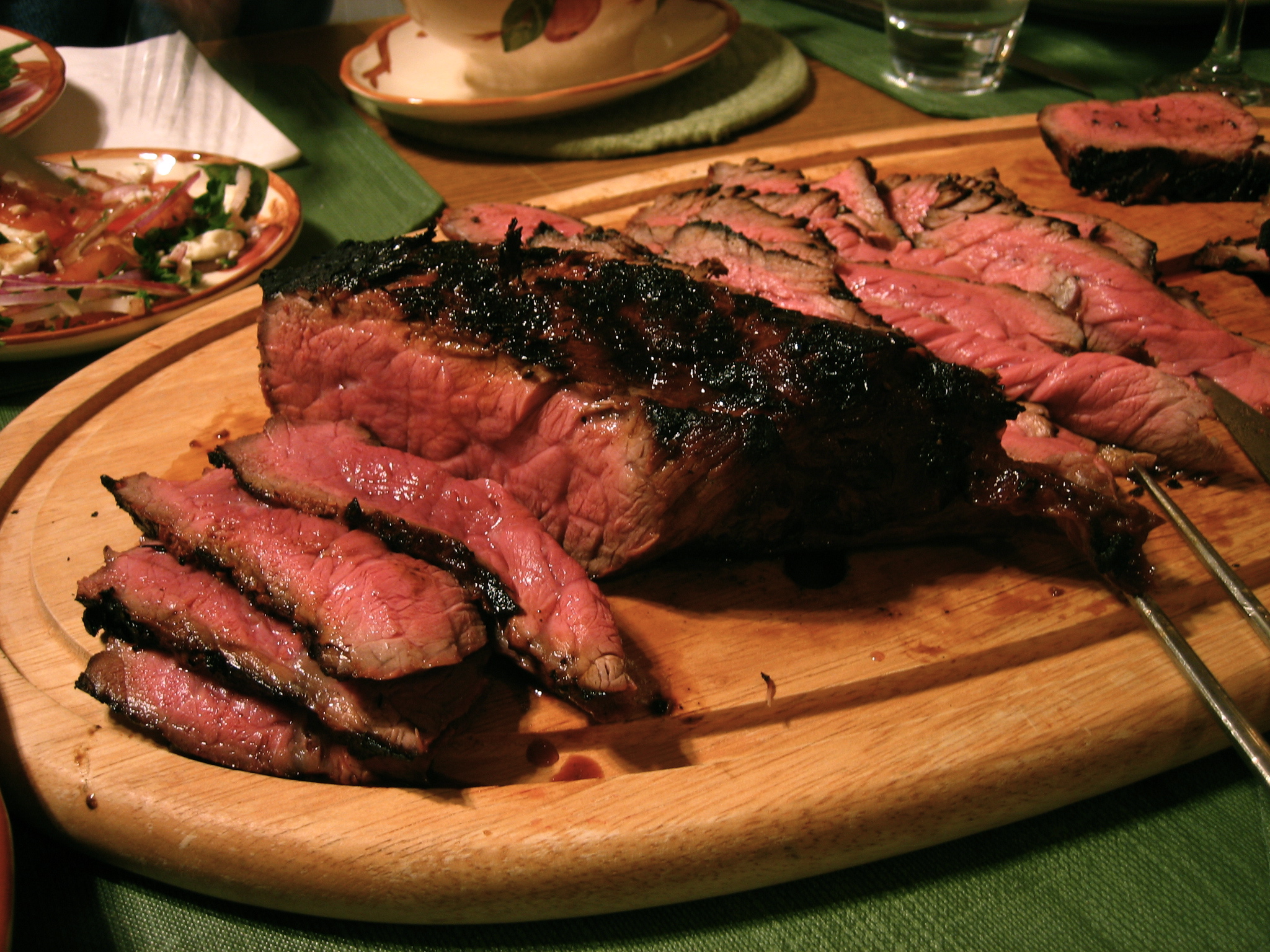|
Prime Rib
A standing rib roast, also known as prime rib, is a cut of beef from the primal rib, one of the primal cuts of beef. While the entire rib section comprises ribs six through 12, a standing rib roast may contain anywhere from two to seven ribs. It is most often roasted "standing" on the rib bones so that the meat does not touch the pan. An alternative cut removes the top end of the ribs for easier carving. Rib-eye steaks are cut from a standing rib, boned with most of the fat and lesser muscles removed. While often referred to as "prime rib", the USDA does not require the cut to be derived from USDA Prime grade beef.USDThe Food Standards and Labeling Policy Bookpg. 154 Characteristics A slice of standing rib roast will include portions of the so-called "eye" of the rib, as well as the outer, fat-marbled muscle (spinalis dorsi) known as the "cap." The traditional preparation for a standing rib roast is to rub the outside of the roast with salt and seasonings and slow-roast with ... [...More Info...] [...Related Items...] OR: [Wikipedia] [Google] [Baidu] |
Cut Of Beef
During butchering, beef is first divided into primal cuts, pieces of meat initially separated from the carcass. These are basic sections from which steaks and other subdivisions are cut. Since the animal's legs and neck muscles do the most work, they are the toughest; the meat becomes more tender as distance from hoof and horn increases. Different countries and cuisines have different cuts and names, and sometimes use the same name for a different cut; e.g., the cut described as "brisket" in the US is from a significantly different part of the carcass than British "brisket". "Cut" often refers narrowly to skeletal muscle (sometimes attached to bones), but can also include other edible flesh, such as offal (organ meat) or bones without significant muscles attached. American The following is a list of the American primal cuts, and cuts derived from them. Beef carcasses are split along the axis of symmetry into "halves", then across into front and back "quarters" (forequarters a ... [...More Info...] [...Related Items...] OR: [Wikipedia] [Google] [Baidu] |
Primal Cut
A primal cut or cut of meat is a piece of meat initially separated from the carcass of an animal during butchering. Examples of primals include the round, loin, rib, and chuck for beef or the ham, loin, Boston butt, and picnic for pork. Different countries and cultures make these cuts in different ways, and primal cuts also differ between type of carcass. The British, American and French primal cuts all differ in some respects. For example, rump steak in British and Commonwealth English is commonly called ''sirloin'' in American English. British ''sirloin'' is called ''porterhouse'' by Americans. Another notable example is fatback, which in Europe is an important primal cut of pork, but in North America is regarded as trimmings to be used in sausage or rendered into lard. The primal cuts may be sold complete or cut further. The distinct term ''prime cut'' is sometimes used to describe cuts considered to be of better quality; for example in the US Department of Agriculture meat gr ... [...More Info...] [...Related Items...] OR: [Wikipedia] [Google] [Baidu] |
Rib-eye Steak
The rib eye or ribeye (known as Scotch fillet in Australia and New Zealand) is a boneless rib steak from the rib section. Description Ribeye steaks are mostly composed of the longissimus dorsi muscle but also contain the complexus and spinalis muscles. The longissimus dorsi is also referred to as the "eye of the ribeye". The spinalis is also referred to as the "ribeye cap" and the complexus is a small muscle at the front of the ribeye which may be trimmed off by the butcher. It is both flavoursome and tender, coming from the lightly worked upper rib cage area which spans from the sixth to twelfth ribs of the cattle. Its marbling of fat makes it very good for fast and hot cooking. Terminology * In Australia and New Zealand, "ribeye" refers to a bone-in rib steak, while the boneless ribeye is known as "Scotch fillet" or "whiskey fillet". * In French cuisine, the ''entrecôte'' corresponds to the rib eye steak, while rib steak is called ''côte de bœuf'' (literally: "beef ... [...More Info...] [...Related Items...] OR: [Wikipedia] [Google] [Baidu] |
USDA
The United States Department of Agriculture (USDA) is the federal executive department responsible for developing and executing federal laws related to farming, forestry, rural economic development, and food. It aims to meet the needs of commercial farming and livestock food production, promotes agricultural trade and production, works to assure food safety, protects natural resources, fosters rural communities and works to end hunger in the United States and internationally. It is headed by the Secretary of Agriculture, who reports directly to the President of the United States and is a member of the president's Cabinet. The current secretary is Tom Vilsack, who has served since February 24, 2021. Approximately 80% of the USDA's $141 billion budget goes to the Food and Nutrition Service (FNS) program. The largest component of the FNS budget is the Supplemental Nutrition Assistance Program (formerly known as the Food Stamp program), which is the cornerstone of USDA's ... [...More Info...] [...Related Items...] OR: [Wikipedia] [Google] [Baidu] |
USDA Prime
Countries regulate the marketing and sale of beef by observing criteria of cattle carcasses at the abattoir (slaughterhouse) and classifying the carcasses. This classification, sometimes optional, can suggest a market demand for a particular animal's attributes and therefore the price owed to the producer. USDA grading system In the United States, the United States Department of Agriculture's (USDA's) Agricultural Marketing Service (AMS) operates a voluntary beef grading program that began in 1917. A meat processor pays for a trained AMS meat grader to grade whole carcasses at the abattoir. Such processors are required to comply with Food Safety and Inspection Service (FSIS) grade labeling procedures. The official USDA grade designation can appear as markings on retail containers, individual bags, or on USDA shield stamps, as well as on legible roller brands appearing on the meat itself. The USDA grading system uses eight different grades to represent various levels of ... [...More Info...] [...Related Items...] OR: [Wikipedia] [Google] [Baidu] |
USDA Choice
The United States Department of Agriculture (USDA) is the federal executive department responsible for developing and executing federal laws related to farming, forestry, rural economic development, and food. It aims to meet the needs of commercial farming and livestock food production, promotes agricultural trade and production, works to assure food safety, protects natural resources, fosters rural communities and works to end hunger in the United States and internationally. It is headed by the Secretary of Agriculture, who reports directly to the President of the United States and is a member of the president's Cabinet. The current secretary is Tom Vilsack, who has served since February 24, 2021. Approximately 80% of the USDA's $141 billion budget goes to the Food and Nutrition Service (FNS) program. The largest component of the FNS budget is the Supplemental Nutrition Assistance Program (formerly known as the Food Stamp program), which is the cornerstone of USDA's nut ... [...More Info...] [...Related Items...] OR: [Wikipedia] [Google] [Baidu] |
Barbecue Grill
A barbecue grill or barbeque grill (known as a barbecue or barbie in Australia and New Zealand) is a device that cooks food by applying heat from below. There are several varieties of grills, with most falling into one of three categories: natural gas, gas-fueled, charcoal, or electric. There is debate over which method yields superior results. History in the Americas Grilling has existed in the Americas since pre-Colonial times. The Arawak people of South America roasted meat on a wooden structure called a barbacoa in Spanish language, Spanish. For centuries, the term ''barbacoa'' referred to the wooden structure and not the act of grilling, but it was eventually modified to "barbecue". It was also applied to the pit-style cooking techniques now frequently used in the southeastern United States. Barbecue was originally used to slow-cook hogs; however, different ways of preparing food led to regional variations. Over time, other foods were cooked in a similar fashion, with hambu ... [...More Info...] [...Related Items...] OR: [Wikipedia] [Google] [Baidu] |
Edible Mushroom
Edible mushrooms are the fleshy and edible fruit bodies of several species of macrofungi (fungi which bear fruiting structures that are large enough to be seen with the naked eye). They can appear either below ground (hypogeous) or above ground (epigeous) where they may be picked by hand. Edibility may be defined by criteria that include absence of poisonous effects on humans and desirable taste and aroma. Edible mushrooms are consumed for their nutritional and culinary value. Mushrooms, especially dried shiitake, are sources of umami flavor. Edible mushrooms include many fungal species that are either harvested wild or cultivated. Easily cultivated and common wild mushrooms are often available in markets, and those that are more difficult to obtain (such as the prized truffle, matsutake, and morel) may be collected on a smaller scale by private gatherers. Some preparations may render certain poisonous mushrooms fit for consumption. Before assuming that any wild mushroom is ... [...More Info...] [...Related Items...] OR: [Wikipedia] [Google] [Baidu] |
List Of Steak Dishes
This is a list of steak dishes. Steak is generally a cut of beef sliced perpendicular to the muscle fibers, or of fish cut perpendicular to the spine. Meat steaks are usually grilled, pan-fried, or broiled, while fish steaks may also be baked. Meat cooked in sauce, such as steak and kidney pie, or minced meat formed into a steak shape, such as Salisbury steak and hamburger steak may also be referred to as steak. Beef Beefsteak is a flat cut of beef, usually cut perpendicular to the muscle fibers. Beefsteaks are usually grilled, pan-fried, or broiled. The more tender cuts from the loin and rib are cooked quickly, using dry heat, and served whole. Less tender cuts from the chuck or round are cooked with moist heat or are mechanically tenderized (e.g. cube steak). * – some asado dishes use beef steak * * * * * * * * * * * * * * – term originally referred to the cut of beef used in the dish which is known as skirt steak. * * * * * * * * * * * * ... [...More Info...] [...Related Items...] OR: [Wikipedia] [Google] [Baidu] |
Cuts Of Beef
During butchering, beef is first divided into primal cuts, pieces of meat initially separated from the carcass. These are basic sections from which steaks and other subdivisions are cut. Since the animal's legs and neck muscles do the most work, they are the toughest; the meat becomes more tender as distance from hoof and horn increases. Different countries and cuisines have different cuts and names, and sometimes use the same name for a different cut; e.g., the cut described as "brisket" in the US is from a significantly different part of the carcass than British "brisket". "Cut" often refers narrowly to skeletal muscle (sometimes attached to bones), but can also include other edible flesh, such as offal (organ meat) or bones without significant muscles attached. American The following is a list of the American primal cuts, and cuts derived from them. Beef carcasses are split along the axis of symmetry into "halves", then across into front and back "quarters" (forequarters a ... [...More Info...] [...Related Items...] OR: [Wikipedia] [Google] [Baidu] |




